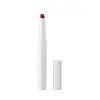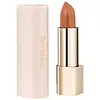KVD Vegan Beauty Epic Kiss Nourishing Vegan Butter Lipstick Versus Rare Beauty Kind Words Matte Lipstick
What's inside
What's inside
 Key Ingredients
Key Ingredients

 Benefits
Benefits

 Concerns
Concerns

 Ingredients Side-by-side
Ingredients Side-by-side

Polybutene
Octyldodecanol
EmollientCoco-Caprylate/Caprate
EmollientPolyethylene
AbrasiveDiisostearyl Malate
EmollientIsononyl Isononanoate
EmollientBis-Diglyceryl Polyacyladipate-2
EmollientHydrogenated Polydecene
EmollientCera Microcristallina
Emulsion StabilisingTheobroma Grandiflorum Seed Butter
Skin ConditioningMorus Alba Leaf Extract
Skin ConditioningHelianthus Annuus Seed Oil
EmollientCarthamus Tinctorius Seed Oil
MaskingHydrogenated Styrene/Isoprene Copolymer
Aroma
Pentaerythrityl Tetra-Di-T-Butyl Hydroxyhydrocinnamate
AntioxidantDicalcium Phosphate
AbrasiveSqualane
EmollientEthyl Vanillin
MaskingSilica
AbrasiveTocopherol
AntioxidantIron Oxides
CI 15850
Cosmetic ColorantCI 77891
Cosmetic ColorantPolybutene, Octyldodecanol, Coco-Caprylate/Caprate, Polyethylene, Diisostearyl Malate, Isononyl Isononanoate, Bis-Diglyceryl Polyacyladipate-2, Hydrogenated Polydecene, Cera Microcristallina, Theobroma Grandiflorum Seed Butter, Morus Alba Leaf Extract, Helianthus Annuus Seed Oil, Carthamus Tinctorius Seed Oil, Hydrogenated Styrene/Isoprene Copolymer, Aroma, Pentaerythrityl Tetra-Di-T-Butyl Hydroxyhydrocinnamate, Dicalcium Phosphate, Squalane, Ethyl Vanillin, Silica, Tocopherol, Iron Oxides, CI 15850, CI 77891
Isononyl Isononanoate
EmollientC12-15 Alkyl Benzoate
AntimicrobialCaprylic/Capric Triglyceride
MaskingOctyldodecanol
EmollientPolyethylene
AbrasiveDicalcium Phosphate
AbrasiveHelianthus Annuus Seed Wax
Skin ConditioningPolybutene
Silica
AbrasiveSynthetic Fluorphlogopite
Microcrystalline Wax
Emulsion StabilisingSynthetic Wax
AbrasiveTocopheryl Acetate
AntioxidantParfum
MaskingHelianthus Annuus Seed Oil
EmollientBHT
AntioxidantGardenia Florida Fruit Extract
Skin ConditioningNelumbo Nucifera Flower Extract
Skin ConditioningNymphaea Odorata Root Extract
RefreshingTitanium Dioxide
Cosmetic ColorantIron Oxides
CI 15850
Cosmetic ColorantCI 42090
Cosmetic ColorantIsononyl Isononanoate, C12-15 Alkyl Benzoate, Caprylic/Capric Triglyceride, Octyldodecanol, Polyethylene, Dicalcium Phosphate, Helianthus Annuus Seed Wax, Polybutene, Silica, Synthetic Fluorphlogopite, Microcrystalline Wax, Synthetic Wax, Tocopheryl Acetate, Parfum, Helianthus Annuus Seed Oil, BHT, Gardenia Florida Fruit Extract, Nelumbo Nucifera Flower Extract, Nymphaea Odorata Root Extract, Titanium Dioxide, Iron Oxides, CI 15850, CI 42090
 Reviews
Reviews

Ingredients Explained
These ingredients are found in both products.
Ingredients higher up in an ingredient list are typically present in a larger amount.
Ci 15850 is the pigment color red. It is an azo dye and created synthetically.
Azo dyes need to be thoroughly purified before use. This allows them to be more stable and longer-lasting.
This ingredient is common in foundations, lipsticks, and blushes. This color is described as brown/orangey red.
It has many secondary names such as Red 6 and Red 7. According to a manufacturer, Red 6 usually contains aluminum.
Learn more about CI 15850Dicalcium Phosphate is an exfoliant.
Helianthus Annuus Seed Oil is the oil derived from the seeds of a Sunflower. Sunflower seed oil is non-fragrant. It is an emollient, meaning it helps to soften the skin.
Sunflower seed oil contains many fatty acids. The fatty acids found in sunflower seeds include (from highest amount to least): linoleic acid, myristic acid, palmitic acid, stearic acid, arachidic acid, oleic acid, and linolenic acid.
These fatty acids help the skin create ceramides. Ceramides play a role in repairing the skin barrier.
Helianthus Annuus Seed Oil helps moisturize the skin. This in turn helps the skin look more rejuvenated and smoother.
Sunflowers are rich in vitamin E.
Historians believe Indigenous cultures of North America domesticated sunflowers before corn. Thus they relied on sunflower oil for a variety of uses. One such use is moisturizing skin and hair.
Sunflower seed oil may not be fungal acne safe. We recommend speaking with a professional if you have any concerns.
Learn more about Helianthus Annuus Seed OilIsononyl Isononanoate is a synthetic skin-conditioner and texture enhancer. It is created from nonanoic acid, a fatty acid found in cocoa and lavender oil.
As an emollient, Isononyl Isononanoate helps keep your skin soft and smooth. This is because emollients create a barrier on the skin to trap moisture in.
Isononyl Isononanoate helps give products a velvet feel and improves spreadability.
Learn more about Isononyl IsononanoateOctyldodecanol is a fatty alcohol. It is primarily used to enhance the texture of products.
As an emulsifier, Octyldodecanol helps prevent the oils and waters from separating. It also prevents ingredients from creating foam when shaken.
Octyldodecanol is created by reducing fatty acid to an alcohol.
Due to its high molecular weight, it does not get absorbed into the skin.
Learn more about OctyldodecanolPolybutene is used to help control the viscosity of a product. This just means it helps adjusts the texture.
It is a polymer and does not get absorbed into the skin due to its large size.
Studies found this ingredient did not irritate skin in concentrations below 15%.
Learn more about PolybutenePolyethylene is a synthetic ingredient that helps the skin retain moisture. It is a polymer.
It is also typically used within product formulations to help bind solid ingredients together and thicken oil-based ingredients. When added to balms and emulsions, it helps increase the melting point temperature.
Silica, also known as silicon dioxide, is a naturally occurring mineral. It is used as a fine, spherical, and porous powder in cosmetics.
Though it has exfoliant properties, the function of silica varies depending on the product.
The unique structure of silica enhances the spreadability and adds smoothness, making it a great texture enhancer.
It is also used as an active carrier, emulsifier, and mattifier due to its ability to absorb excess oil.
In some products, tiny microneedles called spicules are made from silica or hydrolyzed sponge. When you rub them in, they lightly polish away dead skin layers and enhance the penetration of active ingredients.
Learn more about SilicaThis ingredient is a combination of red, black, and yellow iron oxide pigments. This combination of colors is usually found in foundation, because it results in a "skin" color.